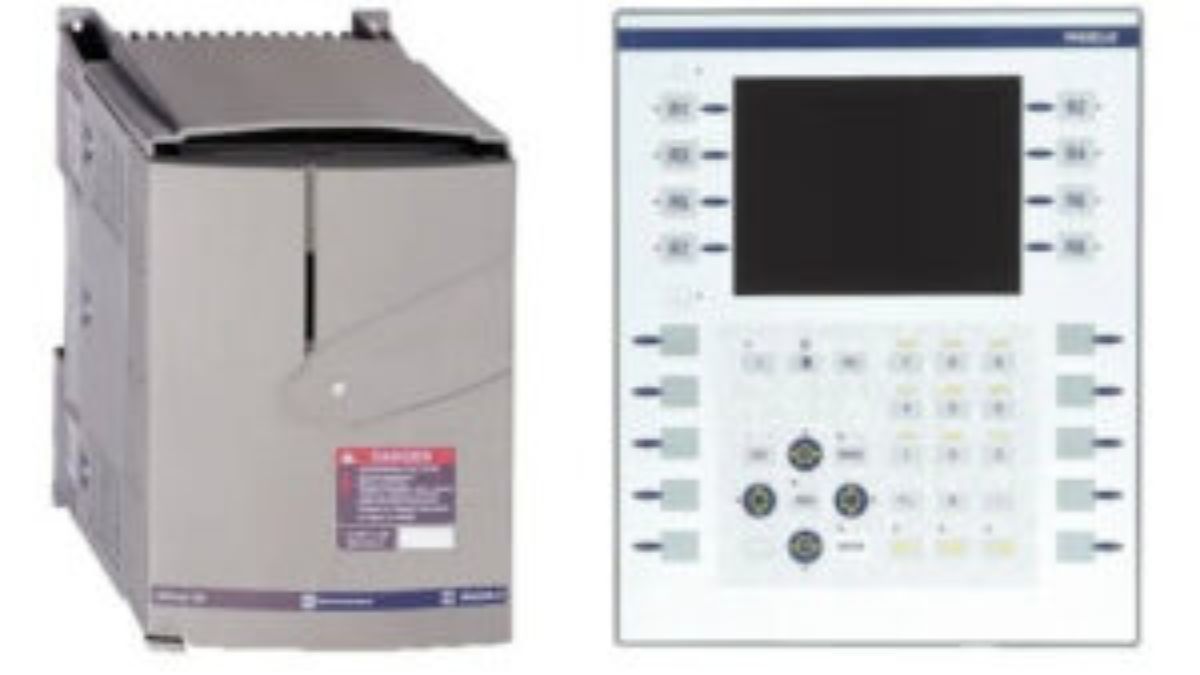TECHNOLOGY
Advanced PLC Features: Exploring Communication Protocols and Networking

Programmable Logic Controllers (PLCs) are the backbone of modern industrial automation systems, offering the ability to control and monitor a wide range of processes, machines, and systems. While PLCs have traditionally been used for discrete control, today’s PLCs come equipped with advanced features that allow them to integrate seamlessly with other devices and systems within the industrial network. One of the key advancements in PLC technology is their enhanced communication capabilities, which support various communication protocols and networking options. These advanced features are critical for enabling real-time data exchange, remote monitoring, and integration with other automation systems like SCADA, Human-Machine Interfaces (HMIs), and Supervisory Control and Data Acquisition systems.
The Importance of Communication Protocols in PLCs
Communication protocols are standardized methods for transmitting data between devices within an industrial control system. For a PLC to operate effectively in a networked environment, it needs to support a wide range of communication protocols that facilitate the exchange of data between different automation components. These protocols ensure that PLCs can communicate with remote devices, sensors, actuators, and other PLCs, allowing for coordinated control and monitoring across multiple systems.
Common PLC Communication Protocols:
- Modbus TCP/IP: A widely used protocol for industrial automation that allows PLCs to communicate over Ethernet networks.
- Ethernet/IP: A high-speed, industrial protocol for real-time control, widely used in process and factory automation.
- Profibus: A protocol for communication between PLCs and field devices, popular in Europe.
- DeviceNet: A protocol designed for connecting industrial devices such as sensors and actuators.
- CANopen: A communication protocol used primarily in motion control applications and in networks of embedded systems.
Networking in PLC Systems
Networking capabilities in PLCs play a critical role in industrial automation by enabling devices to communicate over local area networks (LAN), wide area networks (WAN), or the cloud. Networking allows PLCs to be connected with other PLCs, HMIs, SCADA systems, and other devices, making it possible to monitor and control processes remotely, perform diagnostics, and ensure smooth operations.
Key Networking Features in PLCs:
- Ethernet Port: An essential feature for PLCs that need to connect to a network. Ethernet connectivity enables faster data transfer rates and allows PLCs to communicate with other devices and systems across large distances.
- Wireless Networking: Some advanced PLCs support wireless communication, enabling flexible installations and remote monitoring without the need for wired connections.
- Remote I/O: In large-scale automation systems, remote I/O modules are used to extend the PLC’s reach and gather data from various field devices located far from the main controller.
- Cloud Connectivity: With the rise of the Industrial Internet of Things (IIoT), cloud connectivity has become an essential feature of modern PLCs. PLCs with cloud support enable real-time data monitoring, storage, and analysis, offering enhanced visibility and decision-making capabilities.
Integration with SCADA and HMI Systems
The integration of PLCs with SCADA (Supervisory Control and Data Acquisition) and HMI (Human-Machine Interface) systems is one of the most powerful features of modern automation networks. SCADA systems provide operators with real-time data from PLCs and other devices, enabling them to monitor processes, track performance, and respond to alarms. HMIs provide an interface between operators and the PLC, displaying critical system data in a user-friendly format.
Cybersecurity in PLC Networking
As PLCs become more connected through industrial networks and the IIoT, cybersecurity has become a major concern. Industrial control systems are prime targets for cyberattacks, which can lead to data breaches, system malfunctions, and even safety hazards. To address this, advanced PLCs are equipped with robust security features designed to protect against unauthorized access and cyber threats.
Key Cybersecurity Features in PLCs:
- Encrypted Communication: Many PLCs offer encrypted communication protocols, ensuring that data transmitted over networks is secure from eavesdropping or tampering.
- User Authentication and Access Control: PLCs can be configured to require user authentication, such as passwords or biometric data, to ensure only authorized personnel can access the system.
- Firewall Protection: Some advanced PLCs have built-in firewalls to protect against external threats and prevent unauthorized connections to the network.
PLC Models for Industrial Applications
When selecting a PLC for a particular industrial application, it is important to consider the specific features and capabilities required. For example, the ATV58HU41N4Z is a robust and highly configurable model that offers advanced communication protocols and scalability for complex control systems. This PLC is ideal for applications that require sophisticated monitoring and control features, along with remote communication and network integration. Similarly, the XBTF034510 is designed for applications that demand high-performance and high-reliability, supporting a wide range of communication protocols and advanced networking features.
Both of these models illustrate how the evolving capabilities of PLCs allow them to adapt to the increasing demands of modern industrial systems, providing enhanced flexibility, integration, and communication features.
Conclusion
The advanced communication protocols and networking features in modern PLCs have transformed industrial automation by enabling real-time data exchange, remote monitoring, and seamless integration with other systems. From supporting various communication protocols like Modbus TCP/IP and Ethernet/IP to offering secure cloud connectivity and remote access. These features enhance the flexibility, reliability, and performance of industrial systems. With the rise of IIoT, AI, and advanced cybersecurity.
TECHNOLOGY
Understanding the Rise of Bunkr fi f nheqaf2r5zplr

In the ever-evolving digital world, innovative platforms come and go, but few stand out the way bunkr fi f nheqaf2r5zplr does. Whether you’re a content creator, data archivist, or a tech-savvy enthusiast, you’ve likely noticed the buzz around this curious yet compelling term. But what exactly is bunkr fi f nheqaf2r5zplr? And why is it generating so much attention lately?
Let’s break it all down in this deep-dive article covering the platform’s origin, functions, user benefits, future potential, and much more.
What is Bunkr fi f nheqaf2r5zplr?
At its core, bunkr fi f nheqaf2r5zpl’r appears to be a secure, decentralized content hosting or archiving service with a modern twist. The unusual alphanumeric code at the end — nheqaf2r5zplr — may suggest a personalized access string, a server ID, or even an encrypted node identifier for added privacy. While exact technical specs are scarce, its structure hints at a fusion of file storage, privacy, and decentralized control.
Origins and Development
The origin of bunkr fi f nheqaf2r5zpl’r is shrouded in mystery. Unlike mainstream platforms with clear-cut branding and launch announcements, this system emerged from the underground corners of tech communities. It is believed to be part of a growing ecosystem of open-source, privacy-focused digital lockers — sometimes linked to niche web or blockchain projects.
Core Features of Bunkr fi f nheqaf2r5zplr
1. Secure File Storage
The primary draw of bunkr fi f nheqaf2r5zpl’r is its robust file security. With multi-layer encryption, it protects files from unauthorized access.
2. Anonymous Uploads
Many users appreciate that the platform allows for anonymous content uploads, ensuring digital footprints are minimized.
3. Accessibility
Despite its cryptic appearance, bunkr fi f nheqaf2r5zpl’r is surprisingly accessible. Users only need the right access link to retrieve or upload files.
4. Fast Data Retrieval
Thanks to distributed nodes, file access is incredibly swift. This performance boost has drawn in users tired of slow traditional platforms.
How Bunkr fi f nheqaf2r5zplr Differs From Traditional File Hosting
Traditional file hosting services like Google Drive, Dropbox, or OneDrive rely on centralized servers. This means all your data is stored under one organization’s control — often at the cost of privacy. In contrast, bunkr fi f nheqaf2r5zpl’r leans toward decentralization. Here’s how it stacks up:
Potential Use Cases
1. Archiving Sensitive Research
Scholars and journalists may use bunkr fi f nheqaf2r5zplr to store interviews, reports, or confidential research safely.
2. Sharing Multimedia Projects
Creators can share large media files like videos, music, and graphic portfolios without relying on compression or ad-supported sites.
3. Hosting Private Communities
Private file-sharing groups benefit from the anonymity and exclusivity of this platform.
4. Decentralized Web Integration
This tool may also integrate with decentralized web projects (Web3), becoming a node in a larger blockchain or P2P system.
How to Access Bunkr fi f nheqaf2r5zplr
Accessing this system typically requires a specific link or token. Some forums and tech groups share access points, but most users generate or receive personal invite codes or unique URLs, ensuring tight security and privacy.
Why Is It Gaining Popularity?
In a world where privacy breaches are common, people crave control over their data. Platforms like bunkr fi f nheqaf2r5zplr provide that control. Additionally, its minimalist interface and streamlined upload process appeal to digital minimalists and tech purists alike.
Tech Behind Bunkr fi f nheqaf2r5zplr
1. Decentralized Architecture
By using decentralized networks, the platform avoids single points of failure or control.
2. Peer-to-Peer (P2P) Protocols
Users share bandwidth and storage through P2P connections, reducing costs and enhancing speed.
3. End-to-End Encryption
Every file uploaded is locked with strong cryptographic keys, only accessible to the file owner or recipient.
Security Aspects to Consider
Although bunkr fi f nheqaf2r5zplr offers high-level security, users must also:
-
Avoid sharing access URLs publicly
-
Use strong passwords for private encryption layers
-
Regularly back up important content
The Legal Gray Area
While the platform itself may not be illegal, its privacy features can attract both legitimate and questionable use cases. Therefore, users should be aware of their country’s data-sharing laws.
Pros and Cons of Bunkr fi f nheqaf2r5zplr
Pros:
-
Enhanced privacy and encryption
-
No centralized control
-
Anonymous uploads
-
Fast and efficient
Cons:
-
Difficult to access for beginners
-
Sparse user interface
-
Potential misuse if left unmoderated
The Future of Digital Storage and Platforms Like Bunkr fi f nheqaf2r5zplr
As digital awareness and privacy concerns rise, more platforms will likely follow bunkr fi f nheqaf2r5zplr‘s model. We might even see full integration with crypto wallets, NFTs, and decentralized social networks. The future is certainly encrypted, and bunkr-style systems could lead the charge.
Conclusion
Bunkr fi f nheqaf2r5zplr may seem like an enigma, but it represents a significant shift in how we think about digital storage and sharing. With unmatched privacy, decentralized access, and minimalistic control, it’s a platform built for the future. Whether you’re storing personal art projects or sensitive documents, this tool empowers users to reclaim ownership of their digital presence — safely, quickly, and anonymously.
TECHNOLOGY
Wrome: A Digital Revolution in the Making

The digital age is exploding with innovation, and every so often, a new name catches the attention of tech enthusiasts, digital nomads, and online entrepreneurs alike. One such name is Wrome—a brand or concept that may not yet be in everyone’s vocabulary but is steadily carving its niche in the online world. Whether Wrome represents a platform, a digital tool, a startup, or even a community, it’s becoming synonymous with flexibility, digital freedom, and innovation.
What Is Wrome?
You might be wondering, “What exactly is Wrome?” At its core, Wrome represents the blend of digital mobility, creativity, and empowerment. Though definitions may vary depending on context, Wrome often alludes to a tech-driven environment or tool that redefines traditional norms in communication, productivity, or collaboration. It’s a symbol of how digital innovation continuously reimagines the way we work, live, and connect.
The Philosophy Behind Wrome
Breaking Boundaries Digitally
Wrome is not just a term—it’s a movement. Imagine if the rules of traditional work and digital tools were thrown out the window. What’s left? Wrome. It’s about challenging conventional thinking and offering solutions that blend usability with creativity.
Empowering Users
Wrome places power in the hands of users. Whether it’s through an intuitive interface, seamless functionality, or flexible usage, the concept ensures that individuals feel more in control of their digital environment.
How Wrome Is Changing the Game
The Wrome Approach to Design
Design is the first thing you notice about any product. Wrome has been praised for sleek, minimalist interfaces that make complex tasks feel easy. Think of it as the Apple of whatever space it’s trying to innovate—form meets function in the best way possible.
Wrome and Productivity
Time is money, and Wrome gets that. Its functionalities are tailored toward enhancing productivity, reducing friction, and helping users focus on what matters most. If you’re tired of clunky software or platforms that seem to be stuck in the early 2000s, Wrome might just be your digital savior.
A New Frontier for Remote Workers
The Rise of Digital Nomads
The pandemic reshaped our perception of work. Now, remote work isn’t just a trend—it’s a lifestyle. Wrome caters to this new generation of digital wanderers. With features that support collaboration, time management, and security, it’s becoming a staple in the toolbox of remote professionals worldwide.
Why Wrome Works for Remote Teams
Collaboration is tricky when your team is spread across continents. But Wrome seems to tackle this challenge head-on by offering real-time syncing, integrated video chats, and seamless file sharing.
Wrome in Education
A Tool for Online Learners
Online education is booming, and Wrome doesn’t lag behind. Its platform—if positioned for learning—could offer students an interactive, distraction-free environment that fosters learning without borders.
Empowering Educators
Teachers aren’t left behind either. Wrome enables educators to manage classes, assign homework, and even assess performance through streamlined dashboards. No more juggling multiple tools—just one intuitive system.
Is Wrome a Platform, Product, or Ecosystem?
The Multi-Dimensional Nature of Wrome
Unlike traditional software, Wrome doesn’t seem to limit itself. It behaves more like an evolving ecosystem—modular and expansive. Whether you need a simple to-do app or a full-scale project management tool, Wrome adapts.
Integration with Other Tools
Wrome doesn’t try to replace your favorite tools—it integrates with them. From Google Workspace to Slack, from Zoom to Dropbox, it creates an interconnected digital environment.
The Community Powering Wrome
Users as Collaborators
One of Wrome’s strongest suits is its community. Early adopters are often treated not just as users but as collaborators. Through feedback forums, beta testing, and idea boards, Wrome evolves with the people who use it.
Open-Source or Proprietary?
There’s ongoing speculation about whether Wrome will stay open-source or shift toward a proprietary model. Either way, its flexibility and transparent development approach have already won many hearts.
Security and Privacy on Wrome
Digital Safety First
In an age of data breaches and digital paranoia, Wrome takes security seriously. From end-to-end encryption to two-factor authentication, the platform offers robust features to protect its users.
Privacy Policies That Make Sense
Ever read a privacy policy and felt more confused than before? Wrome simplifies the legal jargon, making its data policies transparent and user-friendly.
Mobile Experience of Wrome
On-the-Go Functionality
Wrome’s mobile interface doesn’t feel like a watered-down version of its desktop sibling. It’s fully optimized for smartphones and tablets, ensuring that work doesn’t stop just because you’re away from your desk.
Offline Capabilities
Lost internet connection? No problem. Wrome allows offline access and automatic syncing once you’re back online—a blessing for those working in remote areas.
Wrome vs. the Competition
Unique Selling Points
Wrome stands out through its adaptability. While other platforms are niche-focused, Wrom’e tries to be everything you need in one package, without the complexity of traditional enterprise tools.
What the Reviews Say
Users praise Wrom’e for its intuitive design and multi-functionality. It’s often compared favorably to legacy tools like Trello, Notion, or Basecamp but is recognized for its broader application range.
The Future of Wrome
What’s Next?
The roadmap for Wrom’e is ambitious. From AI-powered task suggestions to automated workflows, the future looks exciting. If they follow through, Wrom’e could become a household name in the digital productivity space.
Is It Here to Stay?
Trends come and go, but Wrom’e seems to be building something more sustainable. With its growing user base and continual updates, it’s poised for long-term success.
Wrome in Pop Culture and Media
Building a Digital Identity
Wrom’e isn’t just functional—it’s becoming a brand. From appearances in tech podcasts to reviews on YouTube, it’s gathering cultural clout. Expect to hear more about it in digital conversations and maybe even mainstream tech journalism.
Memes and Branding
As odd as it may sound, Wrom’e memes are a thing now. They capture everything from how easy it is to use to humorous takes on productivity guilt. That’s a sign of a platform becoming part of digital culture.
Should You Try Wrome?
The real question is, why not? Whether you’re a freelancer, teacher, student, or startup founder, Wrom’e seems tailored to make your life easier. It’s one of those tools that feels like it was made just for you.
Conclusion
In a world overflowing with digital tools, Wrome stands tall as a symbol of adaptability, simplicity, and user empowerment. It combines the best of what’s out there with a fresh perspective that dares to reimagine productivity. Whether it’s through innovative features, thoughtful design, or community-driven evolution, Wrom’e is fast becoming a name you’ll want to keep an eye on. So, if you’re ready to upgrade your digital life, Wrom’e might just be your next best click.
TECHNOLOGY
Understanding 185.63.2253.200: A Deep Dive into Mysterious IP Formats

If you’ve ever stumbled upon the string 185.63.2253.200, you might have wondered what it represents. Is it a legitimate IP address? A domain? A trap? Or something else entirely? Let’s unravel this string and explore the broader context surrounding it, especially its implications in the digital world.
Is 185.63.2253.200 a Valid IP Address?
Before diving into technical details, here’s the most direct answer: 185.63.2253.200 is not a valid IPv4 address.
IPv4 addresses follow a specific format: four sets of numbers separated by periods, with each number (called an octet) ranging from 0 to 255. In this case, the third octet is 2253, which exceeds the maximum value of 255. Therefore, from a technical standpoint, 185.63.2253.200 is invalid and would not be routable across standard networks.
Why Do People Search for 185.63.2253.200?
Despite its invalid status, this string has gained attention. Some common reasons include:
-
Typos in configuration files
-
Suspicious URLs or phishing attempts
-
Placeholders in tutorials
-
Logging errors or spoofed headers
Whatever the cause, the mystery around it invites deeper analysis.
IPv4 Format: The Basics
How IP Addresses Work
An IP address acts like a mailing address for your device on a network. It allows other machines to find, send data, and communicate with your system. Think of it like your house number in a digital city.
IPv4 vs IPv6
IPv4 is the older standard and uses 32 bits, resulting in over 4 billion possible addresses. IPv6, the newer system, uses 128 bits—offering an incomprehensibly larger pool of unique addresses.
Since 185.63.2253.200 attempts to mimic an IPv4 address, let’s break that format down.
Octets in IP Addresses
Each Part Has a Limit
An IPv4 address is made up of 4 octets (like 185, 63, 2253, 200), each separated by a dot. The catch? Each octet must be between 0 and 255. That’s the golden rule.
So, while “185”, “63”, and “200” are valid octets, “2253” breaks the rule, making the address invalid.
Common Misuses and Errors
Typographical Mistakes
In IT configurations, it’s easy to mistype IP addresses. A stray “3” in 253 can become 2253. These mistakes can lead to failed network connections or security vulnerabilities.
Spoofed IP Headers
Some attackers forge IP headers to mask their real identities. Invalid addresses like 185.63.2253.200 may be inserted to confuse analysts or fool spam filters.
Placeholder IPs
Certain strings like this might also appear in training content or software documentation, accidentally or intentionally, as placeholders—meant to be replaced with real IPs.
Security Implications of Invalid IPs
Red Flags for Cybersecurity Tools
Invalid IP addresses often raise suspicion in security logs. They can signify:
-
Malware behavior
-
Phishing links
-
Data exfiltration attempts
-
Configuration errors
Security analysts often flag these during incident response, especially if such IPs repeatedly show up in logs.
Used in Phishing or Malware
In some malicious emails or fake websites, attackers might use a misleading IP format like 185.63.2253.200 to trick users or evade filters.
How to Analyze Suspicious IP Strings
Check Format First
Always start by verifying whether the IP string is correctly formed. Use tools like ipcalc or online IP validators.
Reverse DNS Lookup
Try to resolve the IP to a hostname using reverse DNS. Though invalid addresses won’t resolve, this is part of standard analysis.
Check Threat Databases
Enter the IP into services like VirusTotal or AbuseIPDB. Even malformed IPs might be documented as part of larger campaigns.
Developer and Admin Best Practices
Always Validate Input
When developing software that interacts with IPs, use validation tools and regular expressions to prevent input of invalid addresses.
Implement Logging Safely
Logs that accept external input must be sanitized. Malformed IPs like 185.63.2253.200 might be attempts to inject bad data.
What If You See 185.63.2253.200 in Logs?
Step-by-Step Reaction
-
Validate the format – Confirm it’s not just a typo.
-
Check origin – Was it an internal process or an external connection?
-
Scan for other anomalies – Are there more malformed entries?
-
Correlate with threat data – Use your threat intel platforms.
-
Block or investigate as needed – Treat repeated entries with caution.
Educational Use or Placeholder?
Some websites or forums might include strings like 185.63.2253.200 in tutorials to show what not to do. While using an obviously invalid IP prevents accidental exposure, it can confuse newcomers.
Tip: Stick to clearly defined reserved IP ranges like 192.0.2.0/24 (used for documentation) instead of random, invalid formats.
How Malicious Actors Use IP Tricks
Camouflage and Obfuscation
Using strange or invalid-looking IPs is a tactic to:
-
Avoid IP blacklists
-
Confuse analysts
-
Exploit parser weaknesses
Encoding and Redirection
Some hackers encode URLs or use deceptive redirect patterns that involve malformed IPs. While the browser rejects them, poorly coded systems might not.
185.63.2253.200 and SEO Spam
Interestingly, you may also see this string in SEO spam comments or low-quality websites. Why?
Spammers sometimes flood forums or blogs with seemingly technical IPs to:
-
Trick search engines
-
Mimic legit traffic
-
Distract moderation
If you’re managing a site, filter out such junk using intelligent comment moderation tools.
Can Such IPs Harm Your Network?
Not directly—since 185.63.2253.200 is invalid, your router won’t send data to it. However, it may indicate deeper problems like:
-
Vulnerable applications
-
Misconfigured firewalls
-
Unpatched software accepting malformed input
Using Proper IP Ranges for Testing
Always use reserved IPs for development and documentation. Valid testing ranges include:
-
192.0.2.0/24 -
198.51.100.0/24 -
203.0.113.0/24
These won’t route on the public internet and are ideal for safe training and testing.
Conclusion
The string 185.63.2253.200 might look like an IP address, but it’s not valid due to its out-of-range octet. While it may seem harmless or accidental, such malformed entries can signal deeper issues—ranging from typos and misconfigurations to potential cyber threats. Always be cautious when such strings appear in your logs or emails. When in doubt, validate, investigate, and don’t ignore it.
-

 TOPIC12 months ago
TOPIC12 months agoInvitation Printing: How to Create Perfect Invitations for Any Occasion
-

 TECHNOLOGY1 year ago
TECHNOLOGY1 year agoAbout Technology From Axiumtechnet: Exploring the Beautiful Future
-

 TECHNOLOGY1 year ago
TECHNOLOGY1 year agoThe Rise of Hqpotner: Exploring Its Impact on the Blogging Community
-

 TECHNOLOGY1 year ago
TECHNOLOGY1 year agoAlpha Technologies Fxm350 Snmp Oid: Comprehensive Overview
-

 BUSINESS1 year ago
BUSINESS1 year agoGoogle Business Profile Kgmid Extractor: A Deep Dive
-

 FASHION12 months ago
FASHION12 months agoUnderstanding Influencersginewuld: The New Wave of Digital Marketing
-

 BUSINESS1 year ago
BUSINESS1 year agoDining Delights: 200 E Business Hwy 23 Walsco Tx
-

 FASHION1 year ago
FASHION1 year agoFashion Guide Lwspeakstyle: What You Need To Know
